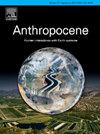Sedimentary records from an alpine wetland in southwestern China reveal the timing of Anthropocene human impact
IF 3.9
2区 地球科学
Q2 ENVIRONMENTAL SCIENCES
引用次数: 0
Abstract
Quantitatively distinguishing the historical record of potentially harmful trace element (PHTE) pollution in alpine wetland sediments enables an understanding of the nature and scale of Anthropocene human impact. In this study, we present PHTE and stable isotope (Pb and Hg) records for a sediment core from Jiulongchi wetland, Fanjing Mountain, southwest China. We calculate the chemical index of alteration and enrichment factors, and conduct multivariate statistics to reveal that the PHTEs in these wetland sediments were mainly regulated by weathering and erosion processes, as well as organic matter content. The pollution history for the last 1300 years is reconstructed from stable Pb and Hg isotopes, PHTE enrichment factors and accumulation rates. Coal combustion is shown to be a major anthropogenic source for PHTE input into the wetland, commencing in the 1940s and amplified during the 1950s. The research findings reflect the pattern of anthropogenic environmental changes in a remote tourist-hotspot area, which can aid in formulating policies to achieve a sustainable and environmentally healthy future for a vulnerable but important ecosystem.
中国西南部高寒湿地的沉积记录揭示了人类世人类影响的时间
定量区分高寒湿地沉积物中潜在有害微量元素(PHTE)污染的历史记录有助于了解人类世人类影响的性质和规模。本文研究了中国西南梵净山九龙池湿地沉积物岩心的PHTE和稳定同位素(Pb和Hg)记录。我们计算了蚀变因子和富集因子的化学指数,并进行了多元统计,发现这些湿地沉积物中的PHTEs主要受风化和侵蚀过程以及有机质含量的调节。利用稳定的Pb和Hg同位素、PHTE富集因子和累积速率重建了近1300年的污染历史。煤炭燃烧被证明是湿地PHTE输入的一个主要人为来源,从20世纪40年代开始,并在50年代扩大。研究结果反映了偏远旅游热点地区的人为环境变化模式,有助于制定政策,为脆弱但重要的生态系统实现可持续和环境健康的未来。
本文章由计算机程序翻译,如有差异,请以英文原文为准。
求助全文
约1分钟内获得全文
求助全文
来源期刊

Anthropocene
Earth and Planetary Sciences-Earth and Planetary Sciences (miscellaneous)
CiteScore
6.30
自引率
0.00%
发文量
27
审稿时长
102 days
期刊介绍:
Anthropocene is an interdisciplinary journal that publishes peer-reviewed works addressing the nature, scale, and extent of interactions that people have with Earth processes and systems. The scope of the journal includes the significance of human activities in altering Earth’s landscapes, oceans, the atmosphere, cryosphere, and ecosystems over a range of time and space scales - from global phenomena over geologic eras to single isolated events - including the linkages, couplings, and feedbacks among physical, chemical, and biological components of Earth systems. The journal also addresses how such alterations can have profound effects on, and implications for, human society. As the scale and pace of human interactions with Earth systems have intensified in recent decades, understanding human-induced alterations in the past and present is critical to our ability to anticipate, mitigate, and adapt to changes in the future. The journal aims to provide a venue to focus research findings, discussions, and debates toward advancing predictive understanding of human interactions with Earth systems - one of the grand challenges of our time.
 求助内容:
求助内容: 应助结果提醒方式:
应助结果提醒方式:


